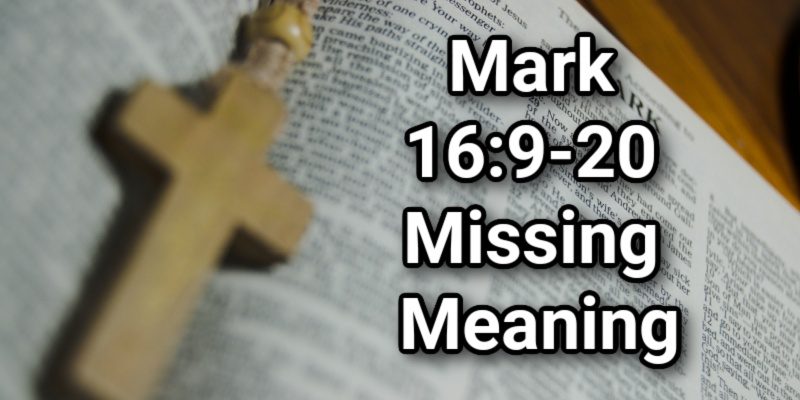Lord’s Library editors offer a Mark 16:9-20 meaning with commentary on why the verses are missing from new Bible versions, for your edification.
 When trying to understand the meaning of Mark 16:9-20 and see why it’s missing in modern versions, first see the verses: “Now when Jesus was risen early the first day of the week, he appeared first to Mary Magdalene, out of whom he had cast seven devils. And she went and told them that had been with him, as they mourned and wept. And they, when they had heard that he was alive, and had been seen of her, believed not. After that he appeared in another form unto two of them, as they walked, and went into the country. And they went and told it unto the residue: neither believed they them. Afterward he appeared unto the eleven as they sat at meat, and upbraided them with their unbelief and hardness of heart, because they believed not them which had seen him after he was risen. And he said unto them, Go ye into all the world, and preach the gospel to every creature. He that believeth and is baptized shall be saved; but he that believeth not shall be damned. And these signs shall follow them that believe; In my name shall they cast out devils; they shall speak with new tongues; They shall take up serpents; and if they drink any deadly thing, it shall not hurt them; they shall lay hands on the sick, and they shall recover. So then after the Lord had spoken unto them, he was received up into heaven, and sat on the right hand of God. And they went forth, and preached every where, the Lord working with them, and confirming the word with signs following. Amen.”
When trying to understand the meaning of Mark 16:9-20 and see why it’s missing in modern versions, first see the verses: “Now when Jesus was risen early the first day of the week, he appeared first to Mary Magdalene, out of whom he had cast seven devils. And she went and told them that had been with him, as they mourned and wept. And they, when they had heard that he was alive, and had been seen of her, believed not. After that he appeared in another form unto two of them, as they walked, and went into the country. And they went and told it unto the residue: neither believed they them. Afterward he appeared unto the eleven as they sat at meat, and upbraided them with their unbelief and hardness of heart, because they believed not them which had seen him after he was risen. And he said unto them, Go ye into all the world, and preach the gospel to every creature. He that believeth and is baptized shall be saved; but he that believeth not shall be damned. And these signs shall follow them that believe; In my name shall they cast out devils; they shall speak with new tongues; They shall take up serpents; and if they drink any deadly thing, it shall not hurt them; they shall lay hands on the sick, and they shall recover. So then after the Lord had spoken unto them, he was received up into heaven, and sat on the right hand of God. And they went forth, and preached every where, the Lord working with them, and confirming the word with signs following. Amen.”
Mark 16:9-20 is the God-given conclusion to the Gospel of Mark—twelve verses that recount Christ’s resurrection appearances, the Great Commission, signs following believers, and His ascension into heaven. Yet in nearly all modern Bible versions—including the ESV, NIV, NASB, and CSB—this entire section is bracketed, footnoted, or worse, outright dismissed as “not found in the earliest manuscripts.” In some editions, the Gospel ends at verse 8, where the women flee the tomb “for they were afraid.” What should be a victorious, world-shaking resurrection account is reduced to silence and confusion. The triumph is muted. The ascension is erased. And the commission to go into all the world and preach the Gospel to every creature is demoted to a questionable appendix. This is not just editorial preference—it is doctrinal vandalism masquerading as scholarship.
Mark 16:9-20 Missing Meaning
Let’s state the facts plainly. Mark 16:9-20 appears in the overwhelming majority of Greek manuscripts. It is found in the Byzantine text tradition, the Latin Vulgate, early church lectionaries, and is quoted or alluded to by church fathers such as Irenaeus, Tatian, Hippolytus, and Augustine—long before the two Alexandrian manuscripts modern scholars cling to were even penned. Irenaeus, writing in the second century, explicitly quotes Mark 16:19 and calls it part of Mark’s Gospel. That is a full century earlier than Codex Vaticanus and Codex Sinaiticus, the two so-called “oldest and best manuscripts” that omit these verses. And it is those two documents alone—along with a few corrupted versions—that have become the excuse for casting doubt on one of the most powerful passages in all of Scripture. The result is a truncated Gospel, suspicious readers, and an erosion of confidence in the integrity of God’s Word.
The content of Mark 16:9-20 is not only doctrinally sound—it is theologically essential. We see the risen Christ appear to Mary Magdalene. We see His rebuke of the disciples’ unbelief. We hear Him command them to preach the Gospel to every creature. We are told that signs will follow believers—not as a prescription for sensationalism, but as a confirmation of divine power in the early Church. And we are given a clear statement of His ascension and enthronement: “So then after the Lord had spoken unto them, he was received up into heaven, and sat on the right hand of God.” To strip this away is to gut the climax of Mark’s Gospel. Ending at verse 8 turns the resurrection into a question mark. Keeping verses 9-20 restores the exclamation point.
The real issue here is not textual—it is philosophical. Modern textual criticism is built on the assumption that the earliest manuscripts must be most accurate, even if they are few in number and disagree with each other thousands of times. That’s how two incomplete, inconsistent, and altered codices from the 4th century are allowed to override 1,600+ years of manuscript agreement, translation consistency, doctrinal testimony, and church usage. It’s a classic case of throwing out the lighthouse because you found an old, broken lantern. The King James Bible includes Mark 16:9-20 because it follows the preserved text, not the fashionable one. And it’s not just the KJV—virtually every Bible in every language for centuries included these verses without question until the late 1800s. That’s when Westcott and Hort, the architects of the critical text, injected doubt into the Church by prioritizing Vaticanus and Sinaiticus over the Received Text.
There is also a spiritual dimension to this attack. Notice what gets lost when you cut out these twelve verses: the post-resurrection ministry of Christ, the command to preach the Gospel to the whole world, the promise of divine power accompanying belief, and the ascension of Jesus to the right hand of God. That’s not a coincidence. That’s a coordinated deletion of resurrection power, evangelistic mandate, and the exaltation of Christ. Satan has always hated those themes. Modern scholars, perhaps unintentionally, have followed him in muting them.
Mark 16:9-20 is Scripture. It is inspired. It is preserved. And it is under attack not because it doesn’t belong, but because it speaks too clearly, too boldly, and too powerfully for today’s tepid theological climate. The King James Bible refuses to bow to corrupt manuscripts or academic trends. It gives you the full Gospel—cross, resurrection, commission, and ascension—without brackets, footnotes, or apologies. If your Bible cuts out the last twelve verses of Mark, it’s not preserving the truth—it’s perverting it. Stick with the Word God preserved. Stick with the Book that finishes what it starts. Stick with the King James Bible.
Lord's Library is a Christian resource hub. Our editors use a variety of internet research methods like search engines, audio and video, AI, consultations with ministry leaders in the field, and more. Lord's Library should never be a substitute for reading your Bible daily as the Scriptures are to be our final authority on all matters. Lord's Library participates in affiliate programs. We may make a small commission from products purchased through this resource.
- Mark 7:16 Meaning: Why is it Missing in Modern Bibles? - June 5, 2025
- What Does the Bible Say about Habits? With Key Scriptures - May 25, 2025
- What Does the Bible Say about Grief? With Key Scriptures - May 24, 2025















